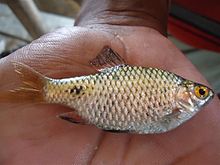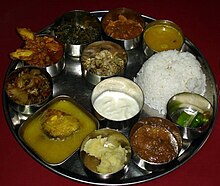Assamese cuisine

| This article is part of the series on |
| Indian cuisine |
|---|
 |
| Part of a series on the |
| Culture of Assam |
|---|
 |
Assamese cuisine is the cuisine of the

A traditional meal in Assam begins with a khar, a class of dishes named after the main ingredient. Another very common dish is tenga, a sour dish. Traditionally, both khar and tenga are not eaten together in the same meal, though it has become common lately. The food is usually served in
Though still obscure, this cuisine has seen wider notice in recent times.[8] The discovery of this cuisine in the popular media continues, with the presenters yet to settle on the language and the specific distinctiveness to describe it.[9]
Ingredients
Rice
Rice is eaten as snack in many forms: roasted and ground (xandoh), boiled in its husk and flattened (chira), puffed (akhoi). kumol saul is rice that is precooked, dried and then husked; it can be simply soaked in warm water and eaten as a light meal.
Rice is a part of all meals in Assam. A traditional breakfast consists of chira with yogurt and jaggery. Mostly farmers eat cooked rice soaked overnight (poita) simply accompanied with salt, mustard oil, onions, etc. Snacks are xandoh, kumol saul or boka saul, sticky rice or bora saul, which can be eaten with sweet or salty accompaniments. For other major meals, rice could be boiled, steamed or wrapped in leaves and roasted. 'Sunga Saul' is a special preparation in which (sticky) rice (bora saul) is cooked in bamboo hollows called 'sunga'. 'Sewa diya Bhaat' is another preparation where sticky rice is steamed over boiling water. They are generally served with meat or fish. Sticky rice is also wrapped in leaves, usually plantain leaves or tora pat, and dropped into boiling water to prepare 'tupula bhat'.
A special class of rice preparations, called pithas are generally made only on special occasions like the Bihu. Made usually with soaked and ground glutinous rice (bora saul), they could be fried in oil with a sesame filling (xutuli pitha), roasted in young green bamboo over a slow fire (sunga pitha) or baked and rolled over a hot plate with a filling (kholasaporia pitha).
Fish

The next most important ingredient is fish, harvested from the many rivers, ponds and lakes in the region. The extremely wet climate and the large numbers of water bodies has ensured that large varieties of fresh water fish are available in abundance in the valley. It is a staple item in the Assamese palate. There is no traditional ethnic community in Assam that does not eat fish. Most traditional rural households have their own ponds for

The mas tenga (sour fish), which is commonly eaten by most communities of Assam, has lately turned into a signature dish of Assamese cuisine. The most popular souring agent for the tenga is
The most common way of eating fish in traditional Assamese homes is by preparing a stew with herbs, vegetables, and greens as per preference and availability. Fish is also prepared by roasting or char-grilling. A common favourite dish is a small fish roasted in banana leaves (paatotdia). Hukoti is a special fish dish prepared from dried small fish like (puthi maas) pounded with arum stem and dried and stored in bamboo tubes. Variations of this exist among the ethnic communities of northeast India in general and Assam in particular. Dried and fermented small fish puthy mas (Ticto barb), three to four in number, are roasted with lavish amounts of green chilis, tomatoes, ginger and garlic (all roasted). The ingredients are then pounded in a mortar to make a coarse paste and served with rice. Fish eggs and innards are also cooked and consumed. Petu bhoja (fried fish intestines) is also considered a delicacy along with the traditional Assamese Jal, which is an herbal fish curry made with medicinal herbs like bhedailota (Chinese fever vine), noroxingho (curry leaves), bon dhunia, man dhunia, manimuni (Asiatic Pennywort), tengesi leaves, and more. It is known for its rich flavour and medicinal and antioxidant qualities.
- See also Fish of Assam
Meat

The Assamese meat and fish dishes are characterized by a low amount of spices and oil, higher quantity of ginger, noroxinghow paat (
The basic cooking methods include cooking, shallow and deep frying. Onla, of the
Most communities of Assam are entomophagous. Various indigenous ethnic groups of certain areas partake of the silkworm, water bugs, grasshoppers, and other insects. Insects are fried or cooked or roasted in leaves and then prepared according to the timing of the meal. The red
Green vegetables
The environs of Assam are rich in vegetation, and green leafy vegetables, called xaak, are an important part of the cuisine. Some of them are grown while others like the dhekia (fern) grows wild. There is a bewildering variety that is eaten and according to custom, one has to have 101 different xaak (greens) during Rongali Bihu. Herbs, greens, and vegetables are commonly eaten by simply cooking in water and salt, lightly frying, as a thick soup or by adding to varieties of lentils. They are also prepared in combination with fish, meat and eggs.
Spices of Assam
Among spices there are
Preparations
Although the modern cuisine of Assam has been influenced to a small extent by East and North Indian cuisine, Assam is still rich in traditional dishes which are similar to the cuisines of East Asian and South-East Asian nations.
Khar

The khar is a signature class of preparations made with a key ingredient, also called khar. The traditional ingredient is made by filtering water through the ashes of the sun-dried skin of a few varieties of
Xôkôta is a severely bitter type of preparation. It is prepared with dry
Masor tenga

The masor tenga is a light and sour
.Naraxingho masor jul
The naroxingho masor jul is another authentic dish from Assam.The fishes are cooked in a light gravy of curry leaves which is a common aromatic herb used in southern and some northern parts of India. The curry leaves are also known as noro-xingho paat in Assamese. The fish preparations in Assam emphasize on retaining the natural flavours of the fish, and hence, few spices are used.
Pura

Pura refers to various forms of grilled and roasted food. Vegetables, meat and fish are often served in this form. Aalu bengena pura pitika, pura maas pitika (mashed grilled fish), pura mankho etc. are a few of the popular dishes.
Poitabhat
Poitabhat is a favourite dish in Assam during the summer season. Cooked rice is soaked overnight and left to ferment. It is and served with mustard oil, onion, chili, pickles, pitika (mashes), etc. The 'poitabhat' preparation is sometimes made alcoholic according to preference.
Pitika - পিটিকা
Side dishes called pitika - পিটিকা (mashes) is a signature characteristic of this cuisine. The most popular is aloo pitika - আলু পিটিকা (mashed
Pickle
Pickles are made of
, etc. Panitenga and kharoli are signature Assamese pickles made from ground mustard seeds.Chutney and salad
Bor
'Bor' are fried balls of mashed lentil or gram — it is equivalent to vada in few other Indian languages. It may contain other green leafy vegetable locally called 'xaak' within it, and it is best while served with 'teteli' (tamarind) curry or dip. There is a huge variety of 'bora' preparations in Assamese cuisine. The base ingredients include greens, vegetables, fruits, flowers, skin, and shoots of various plants. 'Bora' can also be prepared from fish eggs etc.
Fritter
Some other preparations

Some other preparations in Assamese cuisine include Kahudi, Panitenga, Khorikatdiya, Tenga sorsoriya, Posola, etc.
Beer

Liquor is an integral part of linguistically and culturally diverse communities in Assamaese society. Rice is a primary ingredient for the many rice beers (Nam-lao - নাম-লাও) or (Laopani/Xaaj) and liquors made in Assam by different ethnic communities: zou (
), etc.Snacks and cakes
Jolpan
Jolpan (snacks) in
Pitha
Pitha (rice cake) is a special class of rice preparation generally made only on occasions like
It is made in other areas of East and South-East Asia and has similarities with them rather than any Mainland Indian cuisine form etc.
Laru
Larus are
Tea
Tamul
An Assamese meal is generally concluded with the chewing of Tamul (
. It is a routine item after every meal.Notes
- ^ "639 Identifier Documentation: aho – ISO 639-3". SIL International (formerly known as the Summer Institute of Linguistics). SIL International. Retrieved 29 June 2019.
Ahom [aho]
- ^ "Population by Religious Communities". Census India – 2001. Ministry of Home Affairs, Government of India. Retrieved 1 July 2019.
Census Data Finder/C Series/Population by Religious Communities
- ^ "Population by religion community – 2011". Census of India, 2011. The Registrar General & Census Commissioner, India. Archived from the original on 25 August 2015.
2011census/C-01/DDW00C-01 MDDS.XLS
- ^ (Das & Deka 2012)
- ^ "In the book Folk Literature of Assam, Prafulla Dutta Goswami mentions that all kinds of cattle were consumed by the inhabitants of Assam much before the caste system and the colonial order had taken over." (Barman 2018)
- ^ "Inspite of becoming Hindu, the Tai Ahoms have not given up their food habits, i.e., taking pork, beef, chicken, and rice beer." (Gogoi 2011:227)
- ^ Babbar, Purobi Queen Bee Of Assamese Cooking Archived 8 June 2007 at the Wayback Machine
- ^ Krich, John (6 July 2012). "Hot Like Fire: Asia's 5 Spiciest Cuisines 4.Assamese". Time. time.com. Retrieved 22 January 2013.
- ^ Janer, Zilkia (December 2012). "Assamese food and the politics of taste". Seminar (640). Retrieved 22 January 2013.
- ^ Fish Species of Assam
- ^ List of fishes in Kaziranga National Park
- ^ "Masor Tenga Recipe: How to Make Masor Tenga Recipe | Homemade Masor Tenga Recipe".
References
- Barbora, Sanjay (2006) Who needs butter chicken? The search for (and the finding of) a proud Assamese tradition of food, Himal Magazine, November 2006.
- Bhuyan, Biman; Baishya, Krishna (2013). "Ethno medicinal value of various plants used in the preparation of traditional rice beer by different tribes of Assam, India". Drug Invention Today. 5 (4): 335–341. .
- Barman, Rini (16 January 2018). "The myth of 'Assamese Muslim' cuisine". The Hindu Business Line. Archived from the original on 26 November 2021. Retrieved 20 August 2022.
- Das, A. J; Deka, S. C (2012). "Fermented foods and beverages of the North-East India" (PDF). International Food Research Journal. 19 (2). 377-392. Retrieved 30 January 2013.
- Gogoi, Shrutashwinee (2011). Tai ahom religion a philosophical study (PhD). hdl:10603/116167. Retrieved 31 January 2019.
- Goswami, Prashanta (2004) Assam: Feast Northeast, Outlook Traveller, April 2004.
- Goswami, Uddipana (2000) Baptism by Beer: Assamese Cuisine, Tehelka.
- Guha, Amalendu (June 1984). "Pre-Ahom Roots and the Medieval State in Assam: A Reply". Social Scientist. 12 (6): 70. JSTOR 3517005.
- Saleh, Wahid (2007) A few links to Assamese Cuisine, Indiawijzer
- Tamang, Buddhiman; Tamang, Jyoti Prakash (2009). "Traditional knowledge of biopreservation of perishable vegetables and bamboo shoots in Northeast India as food resources" (PDF). Indian Journal of Traditional Knowledge. 8 (1): 89–95. Retrieved 30 January 2013.
